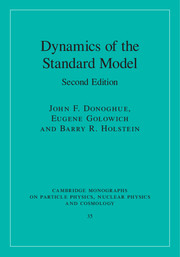Book contents
- Frontmatter
- Dedication
- Contents
- Preface to the second edition
- I Inputs to the Standard Model
- II Interactions of the Standard Model
- III Symmetries and anomalies
- IV Introduction to effective field theory
- V Charged leptons
- VI Neutrinos
- VII Effective field theory for low-energy QCD
- VIII Weak interactions of kaons
- IX Mass mixing and CP violation
- X The N−1c expansion
- XI Phenomenological models
- XII Baryon properties
- XIII Hadron spectroscopy
- XIV Weak interactions of heavy quarks
- XV The Higgs boson
- XVI The electroweak sector
- Appendix A Functional integration
- Appendix B Advanced field-theoretic methods
- Appendix C Useful formulae
- References
- Index
XIV - Weak interactions of heavy quarks
- Frontmatter
- Dedication
- Contents
- Preface to the second edition
- I Inputs to the Standard Model
- II Interactions of the Standard Model
- III Symmetries and anomalies
- IV Introduction to effective field theory
- V Charged leptons
- VI Neutrinos
- VII Effective field theory for low-energy QCD
- VIII Weak interactions of kaons
- IX Mass mixing and CP violation
- X The N−1c expansion
- XI Phenomenological models
- XII Baryon properties
- XIII Hadron spectroscopy
- XIV Weak interactions of heavy quarks
- XV The Higgs boson
- XVI The electroweak sector
- Appendix A Functional integration
- Appendix B Advanced field-theoretic methods
- Appendix C Useful formulae
- References
- Index
Summary
Heavy quarks provide a valuable guide to the study of weak interactions. Measurements of decay lifetimes and of semileptonic decay spectra of heavy, flavored mesons yield information on individual elements of the CKM matrix, as does the observation of heavy-meson particle–antiparticle transitions such as Bd–B̄d mixing. Long anticipated data involving detection of CP-violating signals have been found to be in accord with expectations of the Standard Model and have played a crucial role in constraining the sole complex phase in the CKM matrix.
Heavy-quark mass
At the level of the Standard Model lagrangian, the six quark masses are equivalent; they are all just input parameters that must each be determined experimentally. In the real world of particle phenomenology, quark mass divides into two sectors, ‘light’ (u, d, s) and ‘heavy’ (c, b, t). It is a hallmark of light-quark spectroscopy that hadron mass is not a direct reflection of quark mass. However, for hadrons which contain a heavy quark, the energy scale is set by the mass of the heavy quark. In the following, we discuss topics of special relevance to heavy-quark mass.
Running quark mass
Heretofore we have described the renormalization of quark mass in terms of the mass shift δm = m−m0, where m0 is the bare mass. We can also, for convenience, employ a multiplicative mass renormalization constant Zm with m0 = Zmm.
- Type
- Chapter
- Information
- Dynamics of the Standard Model , pp. 399 - 433Publisher: Cambridge University PressPrint publication year: 2014



